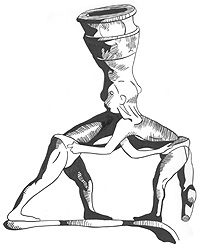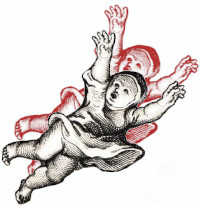The founding slave masters of Plantation America were Christian patriarchs of avowed piety. In defense of, and to propagate the planting of their lesser human creatures on a further shore, these men stood on Biblical tradition, from the laws of Moses down to the letters of Paul. Thomas White in his Planter’s Plea [0] cites Genesis to support his case for planting unwanted souls in an unexploited land. Cotton Mather, some sixty years later, in his ‘Good Master Well Served,’ would cite Scripture and Gospel extensively in support of the master servant hierarchy of the New England that had been planted according to White’s vision.
Yesterday I noted the numerous passages from the relation of Paul’s passage from Judea to Rome that lend the searching eye a perspective on the servile substrata of Late Roman Antiquity. In this portion of the Bible rarely addressed in sermon or discussion of our greatest extant work of literature, I have extracted the passages in quotes below as contextual devices.
…
The following passage concerns Paul’s persecution by the Jews for heresy and his various imprisonments under Roman law.
Acts 22:17-30
Paul Confesses to God
“Lord, they themselves know that in every synagogue I imprisoned and beat those who believed in you. And when the blood of Stephan your witness was shed, I also was standing by and holding the garments of those who killed him.”
It is obvious from this passage, at least in ancient Judea, that places of worship were also used as jails, torture chambers and execution docks. This is another indication that civic jails are not present and that servitude is so widespread that prisoners of little importance might be placed under private ownership. Another means of determining a lack of civic detention space is a lack of provisions for feeding prisoners.
In 22: 22-9 Paul and a tribune discuss how each were a Roman citizen, one by birth the other by purchase, and that such high status people were not to be bound based on charges by non Roman. This was the scene before the pillory post in the barracks where Paul was about to be whipped by a scourge, virtually the same punishment device as the English cat-o’-nine-tails employed 1800 years later. In this passage it is clear that the military barracks was a makeshift prison, indicating that the vast majority of humans were held in bondage by private individuals. For even Plantation America had dedicated jails, which Rome did not.
…
Acts 23
The Plot to Kill Paul
As the tribune discovers that non Roman’s are plotting to kill, Paul, Roman, and that Paul must be judged by a higher authority, it is revealed that the barracks continues as a makeshift jail and that also, the “praetorium” which was the Client king Agrippa’s [1] personal guard barracks, would serve as an even more secure holding area.
Acts 24: 12-31
Paul is Examined by Felix
The governor, who decides to hold Paul orders, “...to the centurian that he should be kept in custody but should have some liberty, and that none of his friends should be prevented from attending to his needs.” [2]
This indicates that though the local barracks served as a jail for temporary holding and the regional guard barracks served as a prison to hold longer term captives, that neither location had provisions to feed the prisoner. This indicates that lower class captives would be sold or punished instantly and that only upper caste men of letters, such as Paul, might be supplied and nursed by friends while awaiting judgment. Paul would be held in this way for two years.
Note that in Plantation America there were numerous jails for detaining and auctioning off runaways and vagabonds. In the ancient case of this religious enforcer having fallen into the ways of those he had been employed to capture, denounce and punish, he is passed up the hierarchy and held in military facilities until he is placed in the kind of confinement known by so many slaves from Antiquity to Modernity, passage by ship.
Acts 27: 1-44:
The relation by Paul of his harrowing voyage aboard ship is in many ways similar to the bondage aboard ship of the pagan god Dionysus, in which the sailors seek to abandon their passenger to the very elements that are their heaven sent punishment for his abduction. As with Dionysus, Paul is visited by an Angel and gives his captors a chance to repent. [3]
The ship is driven aground and Paul relates, “The soldiers’ plan was to kill the prisoners, lest any should swim away and escape.”
He had noted that there were 276 person in the ship, indicating at least 200 captives, and very likely more. In this way Rome, who had HIS political enemies recalled and disposed of at the heart of Empire, was the reverse of Britannia, who exiled HER political enemies to distant doom on a Plantation. Yet the common thread was the ship of sail.
Acts: 28: 1-6
Paul Handles a Serpent over a Fire
After escaping the wrecked ship onto the isle of Malta, Paul was seen by the locals to have been bitten by a serpent while making a camp fire. They thought him a murderer at first, escaped from the “justice” of the sea and now being punished by the snake. But when Paul shook the snake loose into the fire unharmed, “they said that he was a god.”
Paul then cured disease on Malta with prayer and laying on of hands. After being transferred to another prison transport ship Paul will be “set at liberty” assigned private quarters and guarded by a single soldier.
In 28:20 Paul reveals the mechanical nature of his bondage, the same commonly used to bind transports from Great Britain to the Plantations, “...it is because of the hope of Israel that I am bound with this chain.”
And so it was declared by Increase Mather, the Christian patriarch of New England in 1676 that the bondage in chains of the son and wife of Metacomet, the rebel chief would, be led off in chains to make pure, “This New Israel In These Goings Down of The Sun.” This New Israel would, ironically, be repopulated according to the laws of Genesis that decreed a son should leave his father and build a house anew, and that the work would be done by a now invisible army of youths and men brought to its shores in chains.
…
Notes
-0. in A.D. 1631
-1. Named here Herod’s after the king who may have built the facility.
-2. See Samson Agonistes by Milton, in which the Philistines hold Samson in bondage yet permit his family and friends to come feed him.
-3. Ovid, Metamorpheses











